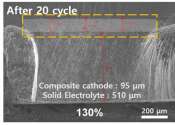In Iceland, CO2 sucked from the air is turned to rock
At the foot of an Icelandic volcano, a newly-opened plant is sucking carbon dioxide from the air and turning it to rock, locking away the main culprit behind global warming.
Nov 2, 2021
4
283
Energy & Green Tech

At the foot of an Icelandic volcano, a newly-opened plant is sucking carbon dioxide from the air and turning it to rock, locking away the main culprit behind global warming.
Nov 2, 2021
4
283
Engineering

Making fresh water out of seawater usually requires huge amounts of energy. The most widespread process for desalination is called reverse osmosis, which works by flowing seawater over a membrane at high pressure to remove ...
May 13, 2021
2
406
Engineering

It takes a lot of fuel to launch something into space. Sending NASA's Space Shuttle into orbit required more than 3.5 million pounds of fuel, which is about 15 times heavier than a blue whale.
Feb 18, 2020
6
3497
Robotics

A soft robot, attached to a balloon and submerged in a transparent column of water, dives and surfaces, then dives and surfaces again, like a fish chasing flies. Soft robots have performed this kind of trick before. But unlike ...
Mar 25, 2019
2
295
Engineering

Often referred to as the "dream batteries," all-solid-state batteries are the next generation of batteries that many battery manufacturers are competing to bring to market. Unlike lithium-ion batteries, which use a liquid ...
Dec 4, 2023
0
108
Engineering

Engineers at the University of California San Diego have developed a soft, stretchy skin patch that can be worn on the neck to continuously track blood pressure and heart rate while measuring the wearer's levels of glucose ...
Feb 15, 2021
0
236
Engineering

A shirt that monitors your blood pressure or a pair of socks that can keep track of your cholesterol levels might be just a few years away from becoming reality.
Dec 1, 2020
0
75
Engineering

Vehicle emissions contribute significantly to global warming effects, although technologies such as hybrid and fully electric vehicles have been introduced in recent years to reduce vehicle emissions. Hydrogen-fueled vehicles ...
Sep 16, 2021
0
17
Energy & Green Tech

Researchers at the Institute of Chemical Technology and collaborators have successfully developed and tested a scale car prototype that stores and generates hydrogen safely and is capable of using it as fuel.
Oct 19, 2018
0
9
Engineering

There's a song anyone who lives near an airport or directly under the flight path of incoming and departing jets daily wishes they could play: Simon and Garfunkel's "The Sound of Silence."
High pressure science and engineering is studying the effects of high pressure on materials and the design and construction of devices, such as a diamond anvil cell, which can create high pressure. By high pressure it is usually meant pressures of thousands (kilobars) or millions (megabars) of times atmospheric pressure (about 1 bar).
It was by applying high pressure as well as high temperature to carbon that man-made diamonds were first produced as well as many other interesting discoveries. Almost any material when subjected to high pressure will compact itself into a denser form, for example, quartz, also called silica or silicon dioxide will first adopt a denser form known as coesite, then upon application of more temperature, form stishovite. These two forms of silica were first discovered by high pressure experimenters, but then found in nature at the site of a meteor impact.
Chemical bonding is likely to change under high pressure, when the P*V term in the free energy becomes comparable to the energies of typical chemical bonds - i.e. at around 100 GPa. Among the most striking changes are metallization of oxygen at 96 GPa (rendering oxygen a superconductor), and transition of sodium from a nearly-free-electron metal to a transparent insulator at ~200 GPa. At ultimately high compression, however, all materials will metallize.[citation needed]
High pressure experimentation has led to the discovery of the types of minerals which are believed to exist in the deep mantle of the Earth, such as perovskite which is thought to make up half of the Earth's bulk, and post-perovskite, which occurs at the core-mantle boundary and explains many anomalies inferred for that region.[citation needed]
Pressure "landmarks": pressure exerted by a fingernail scratching is ~0.6 GPa, typical pressures reached by large-volume presses are up to 30-40 GPa, pressures that can be generated inside diamond anvil cells are ~320 GPa, pressure in the center of the Earth is 364 GPa, highest pressures ever achieved in a shock waves are over 100,000 GPa.[citation needed]
This text uses material from Wikipedia, licensed under CC BY-SA